BIS 2B Final
1/225
There's no tags or description
Looks like no tags are added yet.
Name | Mastery | Learn | Test | Matching | Spaced |
|---|
No study sessions yet.
226 Terms
an interaction between two species living in close association with each other—does not have to be positive
symbiosis
What type of symbiosis is this?
Buffalo infested with parasitic ticks. The oxpecker birds eat the ticks. The buffalo is free from the ticks and the birds are able to get food.
mutualism
interaction between two species, inducing positive effects on both species
mutualism
abiotic (environment conditions) in which a species can survive and reproduce (temperature, precipitation, soil type)
fundamental niche
a match of a species to a specific environment condition
niche
the real conditions in which a species occurs in the wild—incorporate biotic conditions (interactions with other species) as well as abiotic conditions), including BOTH biotic and abiotic
realized niche
The fundamental niche…
A. is generally larger than the realized niche
B. is generally smaller than the realized niche
A
Symbiosis might also affect the _____________ _____________ of a species in a habitat, which causes the population to level off.
carrying capacity
species looking similar, reducing consumption/capture and a predation defense
mimicry
one predator interacts with a single prey, no other factors weighed in, oscillations on graph when shown population of predator and prey— prey pop. decreases, causing predator pop. to decrease as well
Lotka-Volterra model
What are the assumption(s) of the Lotka-Volterra Model?
A. predator populations are low, prey populations rise
B. predator populations increase, prey growth rate slows and population decreases
C. prey populations drop, predator populations drop as well
D. all of the above
D
If there are no prey (victims) in a region, what will happen to the predator population? (Assume 1 prey and 1 predator in the Lotka-Volterra Model)
A. predator will go extinct because there is no food at all for the predator
B. predator population will continue to oscillate
C. predator population will stabilize at a steady size
A
What will happen to the prey population if there are no predators in a region? (Assume 1 prey and 1 predator in the Lotka-Volterra Model)
A. prey will go extinct
B. prey population will continue to go up and down
C. prey population stabilizes at a steady size
D. prey population will grow exponentially because it is only controlled by predators
D
a species that plays a disproportionately large role in the stability and overall diversity of a community—keeps species in check
keystone species
In this example:
The presence of the sea star population preys upon a diversity of sessile invertebrates. On the habitat of a rock, one invertebrate outcompetes the other. The sea star prevents it from dominating and maintaining biodiversity. After the seastars are removed, the less dominating sessile invertebrates decrease in population.
What would the seastar be in this situation?
keystone species
when individuals require the same shared, limiting resource
competition
competition for resources among members of the same species, results in limited growth, reproduction, and/or survival for both competitors
intraspecific
competition for resources between members of different species
interspecific
In an (inter/intra)specific competition, there are only space/resources for some of them to survive.
intra
In an (inter/intra)specific competition, two species competing for an identical limiting resource cannot coexist. Eventually the stronger competitor will drive the weaker competitor to extinction.
inter
two species competing for an identical limiting resource cannot coexist, stronger competitor will drive weaker competitor to extinction
competitive exclusion
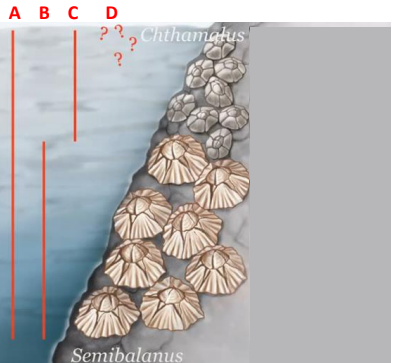
When growing alone, Chthamalus occupies both upper and lower zones.
When growing together, Chthamalus occupies upper tidal zone and Semibalanus takes the lower tidal zone.
When growing alone, Semibalanus only occupies the lower tidal zone.
Which line represents the fundamental niche of Chthamalus?
A
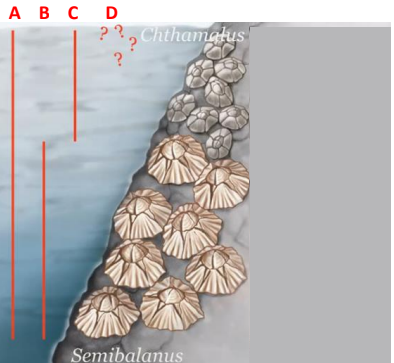
When growing alone, Chthamalus occupies both upper and lower zones.
When growing together, Chthamalus occupies upper tidal zone and Semibalanus takes the lower tidal zone.
When growing alone, Semibalanus only occupies the lower tidal zone.
Which line represents the fundamental niche of Semibalanus?
B

When growing alone, Chthamalus occupies both upper and lower zones.
When growing together, Chthamalus occupies upper tidal zone and Semibalanus takes the lower tidal zone.
When growing alone, Semibalanus only occupies the lower tidal zone.
Which line represents the realized niche of Chthamalus?
C
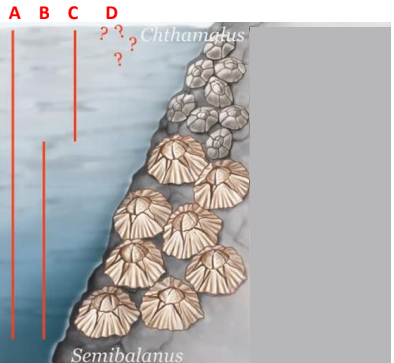
When growing alone, Chthamalus occupies both upper and lower zones.
When growing together, Chthamalus occupies upper tidal zone and Semibalanus takes the lower tidal zone.
When growing alone, Semibalanus only occupies the lower tidal zone.
Which line represents the realized niche of Semibalanus?
B
When growing alone, Chthamalus occupies both upper and lower zones.
When growing together, Chthamalus occupies upper tidal zone and Semibalanus takes the lower tidal zone.
When growing alone, Semibalanus only occupies the lower tidal zone.
This is an example of what principle? What type of coexistence are they in?
competitive exclusion, spatial
species coexist by using resources in different ways; i.e. different physical locations in habitat or using different “parts” of the resource
resource partitioning
Resource partitioning may arise due to ___________ __________________ reducing cmpetition or can reflect shorter-term behavioral changes.
natural selection
species competing fr same resource may diverge in morphology due to natural selection, they evolve to reduce competition—takes place at evolutionary timescales (over generations)
character displacement
When Gray Foxes are found in the same habitats as Coyotes, the foxes shift their diets and focus more on arboreal (tree-dwelling) prey. This is an example of:
A. short-term resource partitioning
B. character displacement
C. competitive competition
D. intraspecific competition
A
Two species of rock nuthatches (birds) have similar body and bill sizes in their allopatric populations. But in a sympatric population (where the species overlap), Sitta neumayer is smaller and has a shorter bill than Sitta tephronota. This is an example of:
A. short-term resource partioning
B. character displacement
C. competitive exclusion
D. intraspecific competition
B
symbiosis where there is a positive effect on one species and neutral on the other (does not affect)
commensalism
A relationship is ________________ for a species if that species cannot survive without the presence of another.
obligate
An obligate relationship is a type of…
mutualism
A relationship is ____________ for a species if it may occur in some conditions but is not required for the species’ survival—necessary for one, neutral for another
facultative
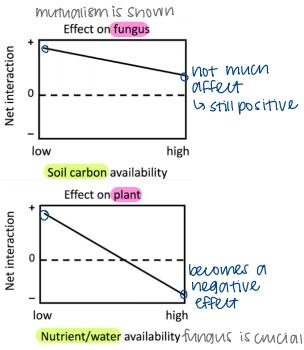
Figures show the relationship between fungi and plants depending on soil resources If a soil has very high levels of carbon, water, and other nutrients, what is the relationship between fungi and plants?
A. mutualism
B. competition
C. parasitism
D. amensalism
C
compare species in two different conditions—can have two different symbiosis due to these different conditions
conditional interactions
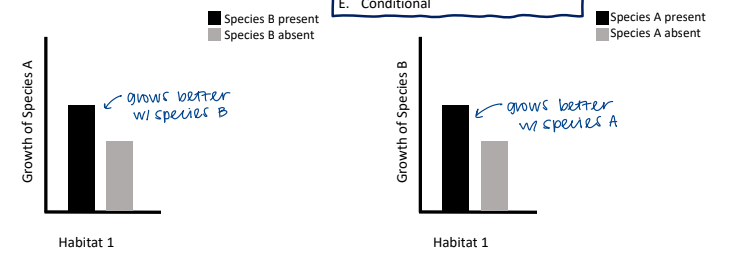
Based on these data, what kind of interaction do Species A and B have?
A. mutualism
B. commensalism
C. competition
D. parasitism/predation
E. conditional
A

Based on these data, what kind of interaction do Species A and B have?
A. mutualism
B. commensalism
C. competition
D. parasitism/predation
E. conditional
E
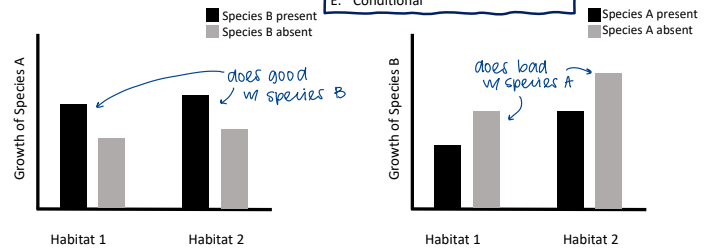
Based on these data, what kind of interaction do Species A and B have?
A. mutualism
B. commensalism
C. competition
D. parasitism/predation
E. conditional
D
the change in species composition within a community over time
succession
change where nearly all life is removed, often there is no soil—type of succession
primary
During __________ succession, the newly colonizing species face limited resources, but also little to no competition or predation due to life being wiped out.
primary
first colonizing habitat after primary succession, good dispersers, poor competitors, short-lives, prolific reproducers (lots of seeds)
pioneer species
Pioneer species are…
A. r-selected
B. k-selected
A
type of succession that refers to change where most of a biotic community is lost but not all; previous population could be restored
secondary
Logging and wildfires are examples of (primary/secondary) succession.
secondary
The two key variables of determining biomes are…
temperature, precipitation
all living things + abiotic factors in a place
ecosystem
high precipitation and temperature, low seasonality in both, does not really change much and stays about the same, close to equator
tropical rainforest
According to Hadley Cells, the biome close to the equator will be significantly (dry/wet).
wet
Which of the following could explain high biodiversity in a region?
A. high speciation rates
B. low extinction rates
C. longer time for which a clade was present in an area
D. any of the above
D
The ____________ is warm enough for growth and more stable for living organisms. There is rain to help grow primary producers for organisms to consume. It will have the highest biodiversity.
tropics
evolution happens faster at higher temperatures—shorter generation times, faster mutation rates, more species interactions, i.e. parasitism
kinetics
stable moisture and sunlight means lots of plant growth in the tropics
productivity
low precipitation and usually high, seasonal temperature, driven in part by Hadley Cells dropping dry air at ~30N and ~30S
desert
rainfall triggers a burst of plant/growth reproduction, which is then tored by many organisms or stored as seeds in the soilh
pulse-reserve paradigm
In a desert biome, after rain, plants flower and product lots of seeds. Those seeds survive in the soil, a “_________ ___________” for many years. Many vertebrates are ____________________ (seed-eaters) to take advantage of seeds in the soil.
seed bank, granivores
fairly low precipitation, seasonality in temperature and precipitation (dry and cold season with low precipitation), limited shrubs and trees but extensive grasses + small flowering plants, well-adapted to fire and grazing by herbivores
temperate grassland
A temperate grassland biome has a (dry/wet) season when cold. When it is hot, it is (dry/wet).
dry, wet
In grasslands, ____________________ limits tree growth, but regularly occurring disturbance also prevent trees from establishing. Fire suppression or the loss of grazing animals can lead grassland to become ___________________________ over time.
precipitation, woodlands
uniquely vulnerable to fire, seasonal temperature and precipitation, hottest months are the driest months, low temp = high precipitation
mediterranean
In a mediterranean biome, when it is dry (no precipitation, it is (hot/cold).
hot
moderate precipitation, seasonality in temperature; only found in northern hemisphere, similar to grasslands but no true dry season
temperate deciduous forest
colder temperatures with seasonal variation, ~5-8 months of freezing temperatures, colder version of temperate forest, moderate precipitation, and no real dry seasons
boreal forest
Boreal forests are only in the (southern/northern) hemisphere.
northern
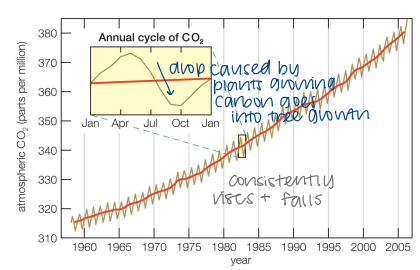
How can we explain the annual cycle of atmospheric CO2?
A. CO2 is produced in Oct-Apr in boreal forests due to lots of decomposition
B. boreal forest growth in May-Sept fixes a lot of CO2 from the atmosphere
C. cycle is explained by the seasonal movement of the ITCZ each year
D. growing season in all biomes takes place between May-Sept
B
“desert of the North”, over or equal to 9 months below freezing temperatures, no full-sized trees due to soil with frozen water (permafrost) and low liquid precipitation
tundra
soil with frost all the time—permanent frost
permafrost
The temperature in the tundra is seasonal. (T/F)
T
The _____________ keeps going towards the pole. This is because the __________________ is retreating northward.
tundra, permafrost
These biomes are highly seasonal or have unpredictable precipitation
A. desert
B. tropical rainforest
C. grassland
D. mediterranean
E. temperate deciduous forest
F. boreal forest
G. A, C, D
H. B, E, F
G

What biome is this?
A. tropical rainforest
B. grassland
C. mediterranean
D. temperate forest
E. boreal forest
B
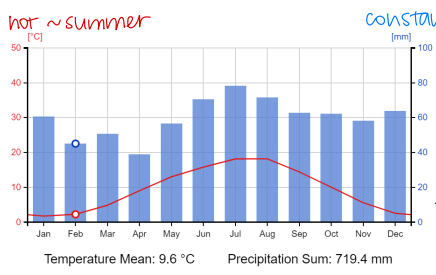
What biome is this?
A. tropical rainforest
B. desert
C. grassland
D. mediterranean
E. temperate forest
E
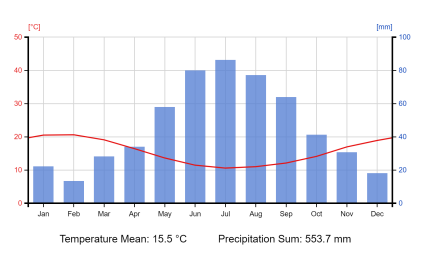
Which biome is this?
A. tropical rainforest
B. desert
C. grassland
D. mediterranean
E. temperate forest
D

Which biome is this?
A. desert
B. grassland
C. temperate forest
D. boreal forest
E. tundra
E
key part of primary productivity
carbon fixation
____________ is measured in grams of carbon per m² per year.
NPP
The global distribution of NPP is:
A. unrelated to global climate
B. shows no association with the ITCZ
C. related to temperature and rainfall patterns
D. highest in the dry regions above and below 30N and S
C
In ____________________ ecosystems, we need to consider temperature, water, and nutrients.
terrestrial
In __________ systems, nutrient distributions are more critical and often related to upwelling.
aquatic
Only bacteria and archaea can fix atmospheric nitrogen. (T/F)
T
The product of nitrogen fixation is ______________. In this form, nitrogen is available to many other organisms.
ammonia
oxidation of ammonia to nitrite and nitrate, requires oxygen
nitrification
reducing nitrate to gaseous nitrogen
denitrification
In ________________ fixation, gaseous nitrogen is fixed into ammonia in soil. _______________________ process nitrification turning it into nitrate. This is then turned back into gaseous nitrogen through ____________________.
biological, chemoautotrophs, denitrificatino
Plants can get inorganic nitrogen from the soil as ammonia/ammonium or via active uptake of nitrate; from manure or compost crops. (T/F)
T
The symbiosis between bacteria and plants is ___________________.
Nodules of the roots of plants use nitrogenase to fix nitrogen as ammonia when in symbiosis with this bacteria. It has other ways of receiving inorganic nitrogen though.
facultative
Specific plants (like rice) can get nitrogen from _______ when grown with these ferms that have symbiotic cyanobacteria.
water
fixation of nitrogen in air through lightning
atmospheric fixation
Atmospheric fixation involves a _________________ strike. It causes the nitrogen to bond with oxygen to form nitrogen oxides. It combines with moisture in the air to fall as _______. This nitrate-rich water supplies ________________ to plants.
lightning, rain, nitrogen
synthesizes ammonia by combining nitrogen from the air with hydrogen under extremely high pressures and moderately high tempratures, in presence of an iron catalyst
Haber-Bosch process
Haber-Bosch process of fixation is ___________________.
industrial
_________________ synthesized ammonia and ______________ industrialized it, making it usable on a big/industrial scale.
Habel, Bosch
Being able to synthesize nitrogen allows for agriculture production to increase. (T/F)
T
The agricultural fixation of nitrogen comes from ________________.
fertilizers
What are the inputs of nitrogen from the atmosphere?
A. atmospheric
B. natural
C. industrial
D. agricultural
E. all of the above
E
_________-_____ occurs when nitrogen is applied to the surface of the Earth and taken up from water, being places back into oceans.
run-off
Excess nitrogen from fertilizer application runs off fields into rivers and lakes. (T/F)
T
If excess nitrogen is supplied, it may be bound by organic matter, volatilize, or be lost through surface run-off. This is a huge problem because it creates ___________ _______ __________.
ocean dead zones